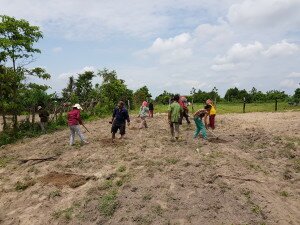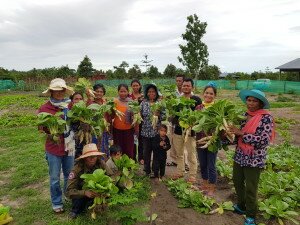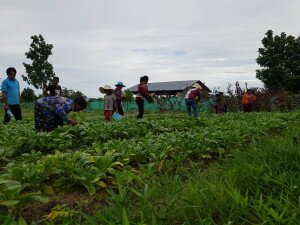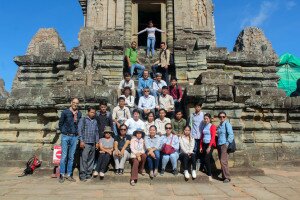Improving livelihoods with vegetable production – GIZ Cambodia
កែលម្អជីវភាពតាមរយៈផលិតកម្មបន្លែរបស់អង្គការ -
ជីអាយហ្សិតកម្ពុជា
បន្លែជាច្រើនប្រភេទដែលដាំដុះលើផ្ទៃដីទំហំ ៣៥ម x ៦០ម ធ្វើឱ្យលោកស្រីទុំ អ៊ិន ពោរពេញដោយស្នាមញញឹមយ៉ាងរីករាយ។ “ខ្ញុំសប្បាយរីករាយណាស់ដែលគម្រោង ILF របស់អង្គការGIZបានជួយគាំទ្រដល់ពួកយើងដើម្បីបង្កើតទីតាំងបង្ហាញនេះ … ច្រើនទៀត >>>
The numerous types of vegetables on the 35 m x 60 m plot of land make Mrs. Tum En smile joyfully. “I am so happy that GIZ ILF has supported us to establish this demonstration plot and trains us adequately so that we can increase our income through better growing techniques… More >>>
Improving livelihoods with vegetable production – GIZ Cambodia
31 August 2018
កែលម្អជីវភាពតាមរយៈផលិតកម្មបន្លែរបស់អង្គការ -
ជីអាយហ្សិតកម្ពុជា
បន្លែជាច្រើនប្រភេទដែលដាំដុះលើផ្ទៃដីទំហំ ៣៥ម x ៦០ម ធ្វើឱ្យលោកស្រីទុំ អ៊ិន ពោរពេញដោយស្នាមញញឹមយ៉ាងរីករាយ។ “ខ្ញុំសប្បាយរីករាយណាស់ដែលគម្រោង ILF របស់អង្គការ GIZ បានជួយគាំទ្រដល់ពួកយើងដើម្បីបង្កើតទីតាំងបង្ហាញនេះ ហើយក៏បានបណ្តុះបណ្តាលយើងគ្រប់គ្រាន់ដើម្បីឱ្យយើងអាចបង្កើនប្រាក់ចំណូលរបស់យើងតាមរយៈការបង្កើនបច្ចេក
ទេសក្នុងការដាំដុះ។ យើងសង្ឃឹមថា ក្រុមគ្រួសារដទៃទៀតនៅក្នុងភូមិរបស់យើង បានមកមើលគម្រោងសួនបន្លែបង្ហាញនេះរបស់យើងដើម្បីរៀនសូត្រ ហើយអាចយកចំណេះដឹងថ្មីៗនេះ ទៅអនុវត្តនៅក្នុងសួនច្បារគ្រួសាររបស់ពួកគេ “។
គម្រោងសួនបង្ហាញនេះ គឺជាផ្នែកមួយក្នុងចំណោមគម្រោងបួនដែលគម្រោង ILF II នៃអង្គការGIZ បានផ្តួចផ្តើមឡើងនៅក្នុងភូមិចំនួន៤ ក្នុងខេត្តកំពង់ឆ្នាំង។ ក្រោមកិច្ចសហការជាមួយក្រសួងរៀបចំដែនដីនគរូបនីយកម្មនិងសំណង់ គម្រោង ILF នៃអង្គការGIZ បានជួយគាំទ្រដល់សម្បទាននិកក្នុងខេត្តទាំង៥ ដើម្បីប្រើប្រាស់ដីដែលពួកគេទទួលបាន និងដើម្បីកែលម្អជីវភាពរស់នៅនិងសន្តិសុខស្បៀងរបស់ពួកគេ។ តួនាទីចម្បងនៃផលិតកម្មបន្លែ អាចជួយបង្កើនរបបអាហារចម្រុះ និងរួមចំណែកដល់ការបង្កើនប្រាក់ចំណូលគ្រួសារឱ្យកាន់តែខ្ពស់។
ជាជំហានដំបូង ក្រុមអ្នកផលិតបន្លែត្រូវបានបង្កើតឡើងនៅតាមភូមិនិមួយៗ ហើយត្រូវបានបណ្តុះបណ្តាលជាជំហានៗ ។ មិនយូរប៉ុន្មានបន្ទាប់ពីនេះ សមាជិកក្រុមអ្នកផលិតបន្លែទាំងនេះ នឹងយកចំណេះដឹងថ្មីៗរបស់ពួកគេ ទៅអនុវត្តនៅក្នុងសួនបន្លែគ្រួសាររបស់ពួកគេ ប៉ុន្តែក៏ត្រូវការការណែនាំបច្ចេកទេសបន្ថែមទៀតផងដែរ។ ដូចគ្នានេះផងដែរ យើងអាចសង្កេតឃើញថា ចំនួនសមាជិកនៃក្រុមអ្នកផលិតនេះមានចំនួនទាប ដូច្នេះសួនបង្ហាញដែលបានផ្តួចផ្តើមឡើងភូមិនីមួយៗអាចផ្សព្វផ្សាយចំណេះដឹងដល់កសិករដទៃ។ សួនបង្ហាញនីមួយៗ ផ្តល់ជូនកសិករពី ១០ ទៅ ២០រូប នូវទំហំដីប្រហាក់ប្រហែលជា ១០ម x ១២ម ដែលពួកគេអាចដាំបន្លែ និងដំណាំផ្សេងទៀត។ ការធ្វើដូច្នេះ អាចជួយកសិករជាច្រើនឱ្យដាំបន្លែបានពេញមួយឆ្នាំ ទោះជាគ្រួសារជាច្រើនជួបប្រទះនូវការខ្វះខាតទឹកនៅរដូវប្រាំងក៏ដោយ។ ចាប់តាំងពីការបង្កើតសួនបង្ហាញនេះកាលពី១ខែកន្លះកន្លងមក កសិករជាច្រើនបានខ្នះខ្នែងដាំបន្លែដោយគ្មានប្រើសារធាតុគីមី និងធ្វើពិពិធកម្មផលិតកម្មរបស់ពួកគេដែលរួមមានម្រុំ ស្គួយផ្អែម សណ្តែកផ្កាយ និងស្លឹកគ្រៃ។ ឥឡូវនេះកសិករទី១ អាចប្រមូលផលបន្លែរបស់ពួកគេជាលើកដំបូងហើយលក់វាទៅឱ្យអ្នកលក់បោះដុំដែលមានតម្លៃខ្ពស់ជាងតម្លៃទីផ្សារ
ធម្មតាដោយសារគុណភាពល្អនៃបន្លែ។ ប្រាក់ចំណូលដែលទទួលបានគឺប្រហាក់ប្រហែលនឹងចំណូលនៃអ្នកធ្វើការរោងចក្រ បូករួមនឹងការមិនចំណាយពេលវេលា និងប្រាក់កាសចំណាយសម្រាប់ការធ្វើដំណើរនិងចំណាយលើម្ហូបអាហារធ្វើឱ្យការផលិតបន្លែកាន់តែមានផល
ចំណេញជាងការទៅធ្វើការនៅខាងក្រៅ។
បច្ចុប្បន្នសមាជិកក្រុមអ្នកផលិតបន្លែត្រូវបានបណ្តុះបណ្តាលអំពីខ្សែសង្វាក់ផលិតកម្ម ដោយគម្រោង ILF នៃអង្គការ GIZ ដើម្បីកែលម្អការរៀបចំក្រុមផលិតករ និងពង្រឹងជំហរទីផ្សាររបស់ពួកគេ។ ហើយតាមរយៈភាពជោគជ័យរបស់អ្នកផលិតបន្លែដំបូងគេ កសិករជាច្រើនចាប់អារម្មណ៍នឹងចូលរួមក្នុងក្រុមនេះក្នុងពេលឆាប់ៗខាងមុខនេះ។

ដើមឡើយ ក្រុមអ្នកផលិតបានរួមគ្នាក្នុងការដាំម្រុំនៅលើសួនបង្ហាញ
In the beginning, the producer group planted moringa together on the demonstration plot
11
11
The numerous types of vegetables on the 35 m x 60 m plot of land make Mrs. Tum En smile joyfully. „I am so happy that GIZ ILF has supported us to establish this demonstration plot and trains us adequately so that we can increase our income through better growing techniques. We hope that all other families in our village visits our demonstration plot to learn and then apply their new knowledge in their own home gardens“.
The demonstration plot is one of four that the GIZ project ILF II (Improvement of Livelihoods and Food Security) has initiated in a total of four villages in the Cambodian province Kampong Chhnang. In cooperation with the Ministry of Land Management, Urban Planning and Construction, GIZ ILF supports land recipients in five provinces to use their allocated land in order to improve their livelihood and food security. A main role plays the production of vegetables as these improve and diversify the family diet as well as contribute to a higher household income.
As a first step, vegetable producer groups were established in each village and trained in consecutive steps. Soon, all members applied their new knowledge in their own home garden, but needed further technical guidance. Also, it was observed that the number of producer group members stayed low, hence the demonstration plots were initiated in each village to spread the knowledge to other farmers. Each of these demonstration plots offer 10-20 farmers a piece of land of approx. 10 m x 12 m on which they can grow vegetables and other crops. This helps many farmers to produce vegetables all year round as many families experience a lack of water in dry season. Since the establishment of the plots 1.5 months ago, many farmers have eagerly grown vegetables without the use of chemicals and diversified the production with moringa, sorghum, Sacha Inchi and lemon grass. Now, the first farmers could harvest their vegetables for the first time and sell it to a wholesaler for a price higher than the usual market price due to the good quality. The generated income is approx. as high as the income of a day of factory work, however no time and money need to be spent for transport and food which makes the vegetable production more profitable.
Currently the vegetable producer group members are trained in ValueLinks by GIZ ILF in order to improve the organisation of their producer group and strengthen their market position. And through the successes of the first vegetable producers, certainly many more farmers will join the group very soon!
Costing of Health services in three Provinces
13 August 2018
Healthcare policy decisions must be based on economic and epidemiological evidence. While knowledge of the epidemiological situation in Cambodia is considerable, little is known about the cost of healthcare services in this country. Existing data is obsolete and frequently not based on a standard methodology. This study was conducted by GIZ in partnership with the Cambodian Ministry of Health (MOH) in 2017, based on data from 2016. The objectives were first, to calculate the unit cost of public healthcare services in Cambodia (health centers, primary and secondary hospitals) as a foundation of evidence-based decision-making; and second, to demonstrate that costing of healthcare services in Cambodia is feasible and can develop into a routine system
The study involved 25 public health facilities: 16 health centers without beds, 4 health centers with beds, 2 provincial hospitals that deliver the “complementary package of activities – level 3″ (CPA3), two CPA2 district hospitals, and one CPA1 hospital.
The fndings show that costing of public healthcare services following a standard methodology is feasible in Cambodia. The results can also be used for managers at various levels of the health system. However, the sample must be broadened, and data collection must become routine practice in order to base policy- and healthcare decision-making on economic evidence. For this purpose, administrative standards in health facilities, operational districts and provincial health departments must be strengthened.
Introduction to Traditional Cambodian Lacquer

Master lacquerer (Eric Stocker) explaining the different layers required during application of natural lacquer.
08 August 2018
Amongst their continuous conservation and restoration efforts in the Angkor Park, the APSARA Stone Conservation Unit (SCU) is currently working on two prestigious late 12th-century Buddha statues at Prasat Pre Rup (as previously mentioned here). Both statues are, as one would expect, typically covered in various coats and layers of natural lacquer and polychromy, including decorative embellishments and faint traces of gold leaf. In order to successfully carry out … More >>>
Introduction to Traditional Cambodian Lacquer

Master lacquerer (Eric Stocker) explaining the different layers required during application of natural lacquer.
08 August 2018
Amongst their continuous conservation and restoration efforts in the Angkor Park, the APSARA Stone Conservation Unit (SCU) is currently working on two prestigious late 12th-century Buddha statues at Prasat Pre Rup (as previously mentioned here). Both statues are, as one would expect, typically covered in various coats and layers of natural lacquer and polychromy, including decorative embellishments and faint traces of gold leaf. In order to successfully carry out any conservation measures to the highest possible standards the topic of historic lacquer conservation needs to be explored further before starting any actual work on this material.
One first step to address this topic adequately has been taken recently in form of a one-day training workshop. On July 5th, 2018 thirty professionals in the field of stone conservation and archaeology from the APSARA Authority as well as the Angkor Conservation Office have been introduced to traditional Cambodian lacquer and its application during an interactive workshop session organised in cooperation between the APSARA Authority and GIZ.
The workshop featured three distinct forms of engagement, starting with a site visit at Prasat Pre Rup to introduce the subject directly at the Buddha statues themselves which enabled all participants to identify a variety of historic lacquer applications as well as developing a better understanding of the context of its utilisation in the past. This was followed by a lecture in the Angkor Training Centre of the APSARA Authority on the history and traditional harvesting and processing methods as well as the common uses of the material in Southeast Asia in which the consultant provided not only theoretical aspects on the topic but also has been available for an extensive question and answer session to clarify any concerns by the participants. Building upon all the acquired conceptual knowledge during the first two sessions, the workshop concluded with its main session focussing solely on the practical methods of application for the remainder of the day. Here the attendees could develop hands-on skills in treating their individual stone sample pieces with traditional natural lacquer techniques following the strict methodological guidance by the consultant in its layered application.
D
We are happy to have been able to engage with Mr Eric Stocker one of the most prominent experts on traditional Cambodian lacquer in the country for this workshop. With his background in professional conservation of historic Southeast Asian lacquer work in French museums he came to Cambodia to re-stablish the traditional use of local natural lacquer 20 years ago. He has since successfully trained numerous locals in these precious skills and continues to do so in his own workshop in Siem Reap to this day.
However, both local lacquer trees as well as its traditional utilisation are in steep decline in modern Cambodia and, unfortunately, with it the skills and knowledge surrounding its harvest, processing and application. For conserving the precious historic Buddha statues at Prasat Pre Rup, as anywhere in the Kingdom, only to the highest professional standards should be applied. This provides an excellent opportunity to respond to the needs of meaningful capacity building for local professionals so that they are not only enabled to best care for their highly valued tangible heritage objects and monuments but also can contribute to the preservation of intangible heritage like traditional skills and capabilities.






